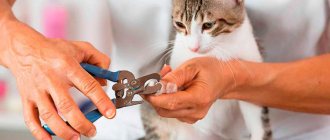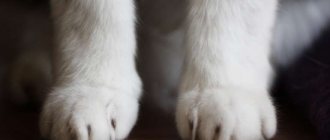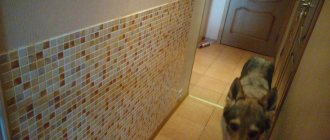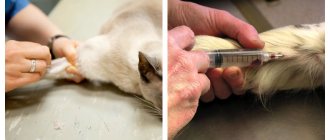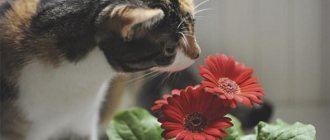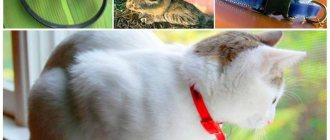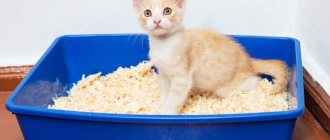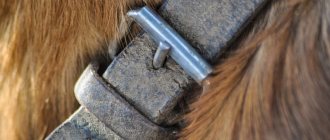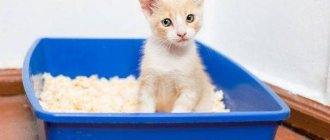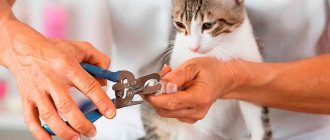Due to their natural instincts, domestic cats regularly sharpen their sharp claws on various objects in the house. Furniture with soft surfaces is most often affected. Some owners who want to eliminate this habit from their animals decide to undergo a special operation that involves declawing their cats. This procedure is also called “soft paws” and “onychectomy.”
Surgical removal can be performed at a veterinary clinic. But should you declaw your cat? To make the right decision, you need to study the benefits of this procedure, as well as all the possible risks and consequences for the animal. It would also be a good idea to seek professional advice from an experienced veterinarian. In our article we will talk in detail about this topic and try to find out how safe onychectomy is for pets.
Declaw removal - onychectomy: pros and cons
Onychectomy is a surgical procedure that involves carefully removing the upper phalanges on the animal’s paws, followed by suturing. The wounds are treated with an ointment with an anesthetic effect, and then bandaged.
This intervention is performed under anesthesia. The owner will have to care for the cat for some time after declawing, following all the doctor’s orders.
Onychectomy is performed for medical reasons:
- damage to the claw phalanx with risks of finger amputation;
- advanced fungal diseases of the claws;
- ingrown claw;
- uncontrollable aggression in an animal.
There are no other indications for this intervention. But despite this, many owners deprive cats of natural protection and many important skills necessary to exist in the environment, solely at their own request.
Of course, if the cat does not go outside, such an operation will not make him particularly damaged. But we still recommend that you carefully consider this idea and decide to perform onychecotomy, correctly weighing all the pros and cons.
Positive influence
Is it possible to call the procedure for declawing cats useful, bringing positive changes to the life of a pet? Of course not, except in cases where the operation is performed purely for medical reasons.
The benefit of a surgical procedure called onychectomy is only to preserve the furniture in the house. The owner will protect his property from damage, but at the same time cause serious mental trauma and physical damage to his furry friend.
Bad influence
Negative aspects are observed already in the first day after the procedure. Poor health, lack of appetite, inability to move independently - these are not all the trials that befell the operated animal.
After a while, the wounds will heal, the cat will gradually begin to come to its senses, an appetite will appear and the ability to move independently, but it will never be able to become the same again. Essentially, your cat will be disabled for life. This is all due to the consequences of onychectomy, which we will now talk about.
Consequences: physical, psychological
Radical declawing operations on domestic cats often have very serious consequences:
- The cat is suffering from excruciating pain.
- Long-term rehabilitation recovery.
- Greater risk of wound infection and prolonged bleeding.
- Impaired gait and grace. The cat has to step on its entire foot, and noticeable lameness appears. But, first, the animal will have to learn to walk again for a long time, which will also create many psychological problems.
- Due to pain and unfamiliarity, the cat becomes inactive, which negatively affects the health of its internal organs. Doctors note that many cats quickly develop diseases of the liver, lungs, stomach and other vital organs after onychecotomy.
- Risks of developing an inflammatory process, which will require a new operation, which may result in severe bleeding, which can be fatal.
- Due to improper gait, which creates increased stress on the spine, the cat may develop diseases of the musculoskeletal system.
- Decreased immunity, susceptibility to various diseases.
- Due to large blood loss after surgery, the cat may die.
When deletion is necessary
If you do not take into account the whim of the owners who take care of their furniture more than a cat, there are situations when the procedure becomes necessary.
Onychectomy is indicated for the following cases:
- The animal was found to have neoplasms in the tissues of its limbs and claws. If traditional treatment fails, your veterinarian may recommend declawing;
- The owner has a serious illness. A bleeding disorder means that even a minor injury can cause irreparable harm to a person. People suffering from this disease are advised to subject their pets to onychectomy.
At what age can onychectomy be performed?
Radical declawing surgery is performed on cats at any age. The most optimal time is from 6 months to a year. Previously, the veterinarian sends the animal for tests and examinations to check the health of the cardiovascular system. This will allow us to determine the risks to the animal’s life after general anesthesia is administered.
Based on the results of the examination, the veterinarian determines exactly when such a procedure can be performed and prescribes a specific time. If problems with the kitten’s health are detected, the specialist will recommend that the owner refrain from radical intervention so as not to risk the life of the pet.
Declawing surgery is performed in specialized veterinary clinics. Some owners negotiate with an experienced doctor to perform an onychectomy at home for a certain fee, believing that the cat will more easily tolerate this intervention within its own walls.
Operation price
If you decide to have an onychectomy, you should not save money. You should entrust the operation to a highly qualified specialist and a veterinary clinic, where your pet will be provided with proper attention.
Entrust the procedure to a highly qualified veterinarian, find out about the experience of performing similar operations
The price for the service is 50-70 dollars. Laser declawing is performed in few clinics and costs approximately $150.
How much does declawing cost for cats?
So, if you are already seriously thinking about carrying out an operation called “soft paws”, you will, of course, be interested in the question - how much does such a procedure cost in Russia?
The cost of onychectomy is ambiguous and depends on the location and level of the veterinary clinic chosen for this procedure. In Moscow and the Moscow region, the price varies between 3000-5000 rubles. In other regions of the country, such intervention can be carried out at a more affordable price (average cost - from 1000 rubles).
Caring for your cat after the procedure
After onychectomy, the cat must be provided with comprehensive care, strictly following all the instructions of the treating veterinarian.
After the operation, the animal’s paws are bandaged, and a special collar is put on the neck. On the first day, the cat leaves after anesthesia; the owner should not leave it unattended. After anesthesia, the pet’s condition will be insane, so there is no need to place the cat on high-lying pieces of furniture. It is better to lay a soft mat on the floor, which will eliminate the risk of falling and injury.
Enhanced care will be required in the first week after radical surgery. To eliminate pain syndromes and speed up recovery, the doctor will prescribe a complex of drug therapy.
What the owner of the operated animal will need to do:
- regularly change bandages and treat wounds with special products prescribed by a veterinarian;
- make sure that the cat does not remove the protective collar, without which it can chew bandages and stitches, which is fraught with quite serious consequences;
- the pet will probably have to receive painkilling injections (as recommended by the doctor);
- Antibacterial therapy is also indispensable;
- every 3-4 days the cat needs to be shown to the veterinarian;
- If bleeding or other adverse effects occur, the pet should be taken to the clinic where the operation was performed as soon as possible.
The rehabilitation period lasts for 3-4 weeks, and sometimes longer. All this time, the owner needs to be extremely attentive to his furry friend.
Influence on behavior
As a result of the fact that the cat cannot protect itself, its behavior changes for the worse. The animal feels constant danger, so it becomes timid. Attacks of aggression towards household members are also possible.
Since the presence of claws is extremely important for cats, removing scratches leads not only to physiological problems, but also to disturbances in the cat’s mental state.
Don't expect that a cat without claws is completely safe. She still has teeth that she can use if she senses the presence of an ill-wisher.
Constant stress causes a cat's immunity to deteriorate. The animal becomes easy prey for viruses and bacteria.
Rehabilitation is long and difficult
It has been noted that cats without claws often refuse to go to the litter box. This is due to the fact that when burying sand, the murka feels pain and discomfort.
Reviews from owners and veterinarians
Before you decide to have a cat declawing operation, we recommend that you read reviews from veterinarians about this procedure:
- most doctors consider this intervention, performed solely at the request of the cat owner, and not for medical reasons, to be inappropriate and even mocking;
- a procedure that is cruel to an animal often causes many serious consequences, so many experienced doctors consider such risks to be completely unjustified;
- many veterinarians fundamentally refuse to perform onychectomy in the absence of medical indications;
- in European countries, onychectomy is officially prohibited;
- Few doctors approve of such an intervention, but still agree to remove the claws of the unfortunate animal, doomed to a painful existence for the rest of its days.
Even if your cat scratches your baby and furniture in the house, there are many other alternative methods to combat this habit. If you cannot do without surgery, doctors in modern clinics can offer a more loyal procedure - laser removal. After such an intervention, the risks of complications are reduced.
Well, now let's get acquainted with the opinion of the cat owners themselves, who once decided to have an onychectomy.
Positive feedback from the owners:
- there are no scratched walls or tattered furniture in the house;
- Children can safely play with the cat without fear of harm.
Negative reviews from owners:
- a rather long and complex healing process for paws;
- It’s painful to watch an animal suffer;
- the cat begins to go to the toilet in the wrong places;
- leaving your pet alone is already scary, because now she has become defenseless and can easily be injured by any wrong movement;
- the cat's behavior has changed for the worse;
- You can’t let him go outside for a walk;
- After declawing, the cat began to limp and health problems appeared.
Possible complications
The first risks are associated with anesthesia. 2% of animals die, even if the patient is healthy and no mistakes were made. There is a high likelihood of an acute immune response, heart and lung problems. Possible disruption of the brain, liver and kidneys, hypothermia - entire textbooks have been written about the consequences of anesthesia.
Modern drugs and hardware monitoring during surgery significantly reduce risks. Therefore, you need to be careful when choosing a clinic, without skimping on transportation, the presence of an anesthesiologist, or hospital care.
| Complication | The essence | Frequency |
| Pain syndrome | Even soft tissues hurt after surgery, and fingers are bones, cartilage, joints, many vessels and nerves. Severe pain must be treated with opiates. | Always |
| Bleeding | There are many relatively large vessels in the fingers. The first day after the “Soft Paws” operation, cat care requires medical supervision. Often the suture is opened due to bleeding. The problematic vessel is cauterized. | Often |
| Phalanx regeneration | Instead of scarring, the amputated finger begins to grow. The claw is formed incorrectly, bent at any angle, including inside the soft tissues. Repeated surgery will help. | Often |
| Abscess | Before the procedure, the hair on the paw is not shaved. This and violation of aseptic standards leads to inflammation of the sutures, purulent lesions, and necrosis. | Rarely |
| Osteomyelitis | Purulent-necrotic inflammation of bones and bone marrow. The amputation site acts as an entry point for infection. | Often |
Long-term use of antibiotics is necessary to suppress dangerous flora. The soft tissues heal quickly - after a week the suture fuses. But when removing the phalanges, they cut directly along the bone, and it takes longer to regenerate. A competent veterinarian will insist on SSD antibiotics for at least a month to avoid local infection.
Is it possible to remove claws at all?
Based on the above facts, we can conclude that such a procedure can be carried out at the discretion of the animal owner, but is it worth risking the health and life of your tailed friend, or is it still possible to find an alternative solution to the problem of scratching furniture and people?
It’s quite possible to stop a cat from damaging furniture and scratching children while playing! There are several effective ways to help you raise an obedient cat without the bad habit of scratching:
- Buy a special accessory - a scratching post and teach your animal to sharpen its claws on this very convenient device! In this simple way you will save expensive furniture in the house and will not deprive your furry pet of its protective claws.
- Be sure to trim your cat's claws as they grow, using a special device - a nail clipper. If you find it difficult to cope with this procedure on your own, seek help from your veterinarian. Clinics perform professional nail trimming for very affordable prices.
- A cat repellent spray will help stop your cat from scratching furniture in a specific place. It has a very unpleasant odor for the animal. You can buy this product at a pet store or veterinary pharmacy.
- To prevent your cat from scratching your children, teach them to play with the animal without using physical force. As a rule, cats do not scratch without a reason; this gesture is performed solely for the purpose of self-defense.
- Special claw covers that visually resemble a nice manicure work quite effectively. Such devices will prevent your cat from scratching walls, furniture and other objects in the house. You can buy miracle pads for sharp claws at a pet store.
It doesn’t matter what kind of cat lives in your house - a British cat, a Scottish cat or an ordinary yard cat, Murka, she is a living creature that deserves your attention and care! Do not subject her to excruciating suffering, think it over several times before you decide to undergo declawing surgery!
Be sure to try using alternative methods to eliminate the annoying scratching habit. If it doesn’t help, consult with an experienced veterinarian and only then make the right decision, which will determine the future fate of your pet!
Prevention methods
To prevent the claw from growing into the paw pad, veterinarians recommend following simple recommendations:
- create conditions for natural grinding of claws. Allow the pet to sharpen its claws to the required height;
- For cats with a genetic predisposition to ingrown and deformed claws, have multiple nail trimming procedures performed at your veterinary clinic. This will straighten the shape of the claw plate and prevent it from growing into the paw;
- If you do not practice walking your cat outside, purchase a high-quality nail clipper. Trim the nails regularly and then carefully file down the edges;
- Inspect your pet's paws as often as possible to identify ingrown claws and other defects. If a problem is detected at an early stage, the claw can be removed without surgery, healing will be faster and easier;
- Protect the animal from injuries to limbs and falls from great heights. This is necessary to prevent deformation and change in the size of the claw.
Remember! If the situation of a claw growing into a paw has already happened, it may happen again. Therefore, carefully monitor your pet.
It is important for owners to know that the most problematic claw is the claw on the fifth toe of the front paws. Anatomically, it is located on the back side above the rest of the cat's fingers. He is actively growing, nothing bothers him. Due to its location, this claw does not reach the surface on which cats grind their claws. Therefore, it is most often the one that grows into soft tissues. The problem of ingrown claws is a common pathology in cats and dogs. It is important to regularly inspect your pet's paws and follow the prevention recommendations above. If you notice an ingrown claw, contact a veterinary clinic as soon as possible. This will help avoid complications. The extraction procedure will be less painful and complicated. No surgery or long recovery period is required.
Trim your nails regularly to protect yourself and your pet from unnecessary problems.
